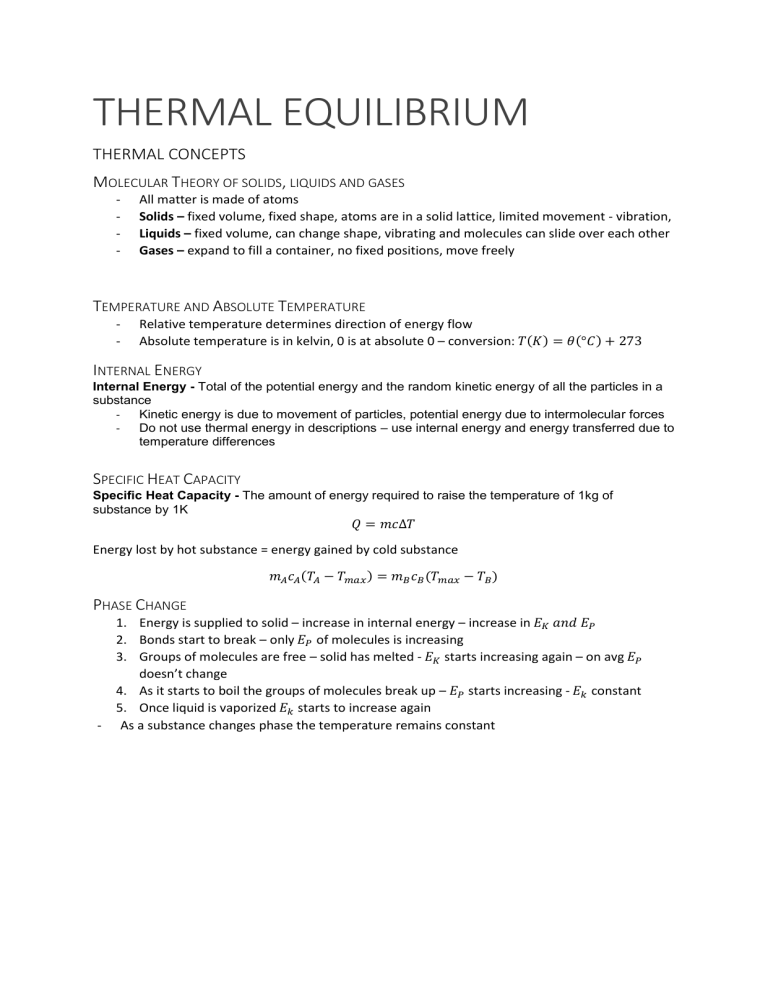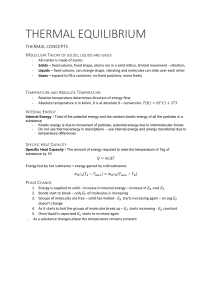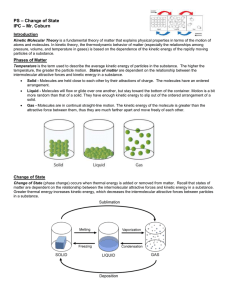
THERMAL EQUILIBRIUM THERMAL CONCEPTS MOLECULAR THEORY OF SOLIDS, LIQUIDS AND GASES - All matter is made of atoms Solids – fixed volume, fixed shape, atoms are in a solid lattice, limited movement - vibration, Liquids – fixed volume, can change shape, vibrating and molecules can slide over each other Gases – expand to fill a container, no fixed positions, move freely TEMPERATURE AND ABSOLUTE TEMPERATURE - Relative temperature determines direction of energy flow Absolute temperature is in kelvin, 0 is at absolute 0 – conversion: 𝑇(𝐾) = 𝜃(°𝐶) + 273 INTERNAL ENERGY Internal Energy - Total of the potential energy and the random kinetic energy of all the particles in a substance Kinetic energy is due to movement of particles, potential energy due to intermolecular forces Do not use thermal energy in descriptions – use internal energy and energy transferred due to temperature differences SPECIFIC HEAT CAPACITY Specific Heat Capacity - The amount of energy required to raise the temperature of 1kg of substance by 1K 𝑄 = 𝑚𝑐Δ𝑇 Energy lost by hot substance = energy gained by cold substance 𝑚𝐴 𝑐𝐴 (𝑇𝐴 − 𝑇𝑚𝑎𝑥 ) = 𝑚𝐵 𝑐𝐵 (𝑇𝑚𝑎𝑥 − 𝑇𝐵 ) PHASE CHANGE - 1. Energy is supplied to solid – increase in internal energy – increase in 𝐸𝐾 𝑎𝑛𝑑 𝐸𝑃 2. Bonds start to break – only 𝐸𝑃 of molecules is increasing 3. Groups of molecules are free – solid has melted - 𝐸𝐾 starts increasing again – on avg 𝐸𝑃 doesn’t change 4. As it starts to boil the groups of molecules break up – 𝐸𝑃 starts increasing - 𝐸𝑘 constant 5. Once liquid is vaporized 𝐸𝑘 starts to increase again As a substance changes phase the temperature remains constant SPECIFIC LATENT HEAT Latent Heat - The energy required to achieve a change of phase Specific Latent Heat of Fusion (melting) - Energy required to change the phase of 1kg of substance from a solid to liquid without a temperature change Specific Latent Heat of Vaporization (boiling) - Energy required to change the phase of 1 kg of substance from liquid to gas without a temperature change. Thermal Equilibrium - When the rate of flow of heat from A to B is equal to that from B to A when they are at the same temperature 𝑄 = 𝑀𝐿 Energy lost in cooling water = energy gained by ice 𝑚𝑤𝑎𝑡𝑒𝑟 𝑐𝑤𝑎𝑡𝑒𝑟 (𝑇𝑤𝑎𝑡𝑒𝑟 − 𝑇𝑚𝑖𝑥 ) = 𝑚𝑖𝑐𝑒 𝐿𝑓𝑢𝑠𝑖𝑜𝑛 + 𝑚𝑖𝑐𝑒 𝑐𝑤𝑎𝑡𝑒𝑟 𝑇𝑚𝑖𝑥 MODELLING A GAS PRESSURE 𝑃= 𝐹 𝐴 EQUATION OF STATE FOR AN IDEAL GAS 𝑃𝑉 = 𝑛𝑅𝑇 - Gas Laws – graphs KINETIC MODEL FOR AN IDEAL GAS Kinetic Model of an Ideal Gas - Gas consists of many small particles in constant random motion Each molecule has negligible volume At any moment as many molecules are moving in one direction as in any other Molecules undergo perfectly elastic collisions - momentum is reversed Energy is entirely kinetic - no intermolecular forces between molecules Duration of a collision is negligible Each molecule produces a force on the wall of the container Forces of individual molecules will average out to produce a uniform pressure throughout MOLE, MOLAR MASS AND THE AVOGADRO CONSTANT Mol - The amount of substance that has the same number of particles as there are neutral atoms in 12 grams of carbon 12. Avogadro Constant – Number of molecules in 1 mol of gas. 6.02 × 1023 Molar Mass – The mass of one mol of substance 𝑛= 𝑁 𝑛𝑢𝑚𝑏𝑒𝑟 𝑜𝑓 𝑎𝑡𝑜𝑚𝑠 = 𝑁𝐴 𝐴𝑣𝑜𝑔𝑎𝑟𝑑𝑜 𝑐𝑜𝑛𝑠𝑡𝑎𝑛𝑡 DIFFERENCES BETWEEN REAL AND IDEAL GASSES - - An ideal gas is one that follows all gas laws Real gasses have some intermolecular forces, don’t have negligible volume, collisions are not always perfectly elastic Real gasses approximate ideal gasses at high temperature and low pressure 𝐸̅𝐾 = - 3 3𝑅 𝑘𝐵 𝑇 = 𝑇 2 2 𝑁𝐴 Internal energy of a gas is entirely kinetic thus: 𝑡𝑜𝑡𝑎𝑙 𝑖𝑛𝑡𝑒𝑟𝑛𝑎𝑙 𝑒𝑛𝑒𝑟𝑔𝑦 𝑜𝑓 𝑎 𝑔𝑎𝑠 = 𝑝𝑉 = 𝑁𝑘𝐵 𝑇 3 𝑁𝑘 𝑇 2 𝐵




